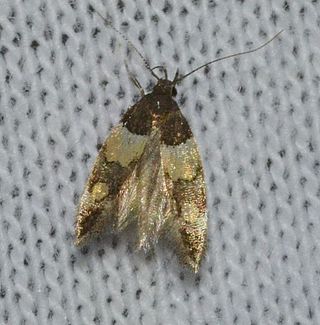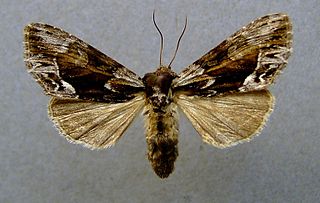
Gomalia elma, also known as the marbled skipper or African marbled skipper, is a species of hesperiid butterfly. It is found in Africa and parts of Asia.
Axyrostola is a genus of moth in the family Gelechiidae. It contains only one species, Axyrostola acherusia, which is found in Burma.

Triclonella is a genus of moths in the family Cosmopterigidae.

Hyppa rectilinea, the Saxon, is a moth of the family Noctuidae. It is found in Europe, but mostly in northern and central Europe. In the south, it is found in scattered populations, mainly in mountainous areas. To the east, its range stretches through northern Asia and eastern Siberia, up to the Pacific Ocean and Japan.
Triclonella elliptica is a moth in the family Cosmopterigidae. It is found in Guyana and Brazil.
Drapetodes interlineata is a moth in the family Drepanidae. It was described by Warren in 1896. It is found in Singapore, on Peninsular Malaya and in Indonesia (Java).
Drapetodes lunulata is a moth in the family Drepanidae. It was described by Warren in 1896. It is found in Indonesia (Java).
Nordstromia humerata is a moth in the family Drepanidae. It was described by Warren in 1896. It is found in north-eastern India.
Gogana abnormalis is a moth in the family Drepanidae first described by Warren in 1897. It is found on Borneo, Sumatra and Peninsular Malaysia.
Oreta unilinea is a moth in the family Drepanidae. It was described by William Warren in 1899. It is found in New Guinea, where it is known from Papua and Roon Island.
Streptoperas crenelata is a moth in the family Drepanidae. It was described by Charles Swinhoe in 1902. It is found on Borneo and Peninsular Malaysia.
Macrothyatira flavimargo is a moth in the family Drepanidae. It is found in western China.
Catacometes hemiscia is a moth in the family Oecophoridae. It was described by Edward Meyrick in 1883. It is found in Australia, where it has been recorded from New South Wales.
Hypatima metaphorica is a moth in the family Gelechiidae. It was described by Edward Meyrick in 1921. It is found in Australia, where it has been recorded from Queensland.
Dichomeris argentaria is a species of moth in the family Gelechiidae. It was described by Edward Meyrick in 1913. It is found in Mpumalanga, South Africa.
Dichomeris hortulana is a moth in the family Gelechiidae. It was described by Edward Meyrick in 1918. It is found in India, South Africa, the Seychelles, where it has been recorded from Silhouette and Mahé as well as Mauritius and Mayotte.
Onebala probolaspis is a moth in the family Gelechiidae. It was described by Edward Meyrick in 1929. It is found in South Africa.
Hypatima corynetis is a species of moth in the family Gelechiidae. It was described by Edward Meyrick in 1913. It is found in Sri Lanka.
Tornodoxa tholochorda is a moth in the family Gelechiidae. It was described by Edward Meyrick in 1921. It is found in Korea, Japan and Zhejiang, China.

Asaphodes cosmodora is a species of moth in the family Geometridae. This species is endemic to New Zealand and has been observed in the South Island. The adults of this species are on the wing in January and February.



